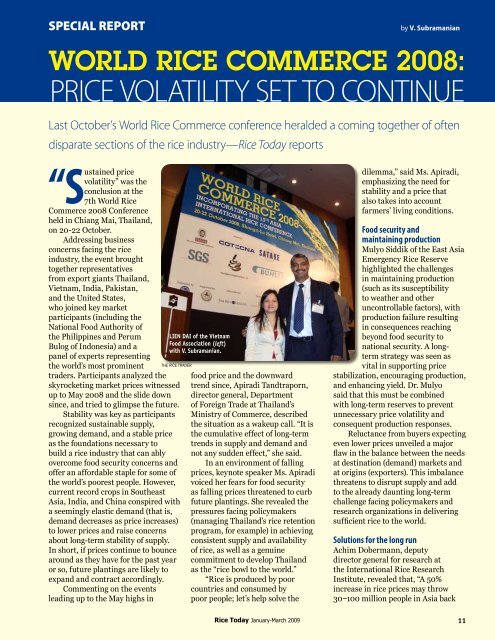How much water does rice need? - adron.sr
How much water does rice need? - adron.sr
How much water does rice need? - adron.sr
Create successful ePaper yourself
Turn your PDF publications into a flip-book with our unique Google optimized e-Paper software.
SPECIAL REPORTLast October’s World Rice Commerce conference heralded a coming together of oftendisparate sections of the <strong>rice</strong> industry—Rice Today reportsby V. SubramanianWorld Rice Commerce 2008:p<strong>rice</strong> volatility set to continuep<strong>rice</strong>volatility” was theconclusion at the“Sustained7th World RiceCommerce 2008 Conferenceheld in Chiang Mai, Thailand,on 20-22 October.Addressing businessconcerns facing the <strong>rice</strong>industry, the event broughttogether representativesfrom export giants Thailand,Vietnam, India, Pakistan,and the United States,who joined key marketparticipants (including theNational Food Authority ofthe Philippines and PerumBulog of Indonesia) and apanel of experts representingthe world’s most prominenttraders. Participants analyzed theskyrocketing market p<strong>rice</strong>s witnessedup to May 2008 and the slide downsince, and tried to glimpse the future.Stability was key as participant<strong>sr</strong>ecognized sustainable supply,growing demand, and a stable p<strong>rice</strong>as the foundations necessary tobuild a <strong>rice</strong> industry that can ablyovercome food security concerns andoffer an affordable staple for some ofthe world’s poorest people. <strong>How</strong>ever,current record crops in SoutheastAsia, India, and China conspired witha seemingly elastic demand (that is,demand decreases as p<strong>rice</strong> increases)to lower p<strong>rice</strong>s and raise concernsabout long-term stability of supply.In short, if p<strong>rice</strong>s continue to bouncearound as they have for the past yearor so, future plantings are likely toexpand and contract accordingly.Commenting on the eventsleading up to the May highs inLIEN DAI of the VietnamFood Association (left)with V. Subramanian.THE RICE TRADERfood p<strong>rice</strong> and the downwardtrend since, Apiradi Tandtraporn,director general, Departmentof Foreign Trade at Thailand’sMinistry of Commerce, describedthe situation as a wakeup call. “It isthe cumulative effect of long-termtrends in supply and demand andnot any sudden effect,” she said.In an environment of fallingp<strong>rice</strong>s, keynote speaker Ms. Apiradivoiced her fears for food securityas falling p<strong>rice</strong>s threatened to curbfuture plantings. She revealed thepressures facing policymakers(managing Thailand’s <strong>rice</strong> retentionprogram, for example) in achievingconsistent supply and availabilityof <strong>rice</strong>, as well as a genuinecommitment to develop Thailandas the “<strong>rice</strong> bowl to the world.”“Rice is produced by poorcountries and consumed bypoor people; let’s help solve thedilemma,” said Ms. Apiradi,emphasizing the <strong>need</strong> forstability and a p<strong>rice</strong> thatalso takes into accountfarmers’ living conditions.Food security andmaintaining productionMulyo Siddik of the East AsiaEmergency Rice Reservehighlighted the challengesin maintaining production(such as its susceptibilityto weather and otheruncontrollable factors), withproduction failure resultingin consequences reachingbeyond food security tonational security. A longtermstrategy was seen asvital in supporting p<strong>rice</strong>stabilization, encouraging production,and enhancing yield. Dr. Mulyosaid that this must be combinedwith long-term reserves to preventunnecessary p<strong>rice</strong> volatility andconsequent production responses.Reluctance from buyers expectingeven lower p<strong>rice</strong>s unveiled a majorflaw in the balance between the <strong>need</strong>sat destination (demand) markets andat origins (exporters). This imbalancethreatens to di<strong>sr</strong>upt supply and addto the already daunting long-termchallenge facing policymakers andresearch organizations in deliveringsufficient <strong>rice</strong> to the world.Solutions for the long runAchim Dobermann, deputydirector general for research atthe International Rice ResearchInstitute, revealed that, “A 50%increase in <strong>rice</strong> p<strong>rice</strong>s may throw30–100 million people in Asia backRice Today January-March 2009 11

















